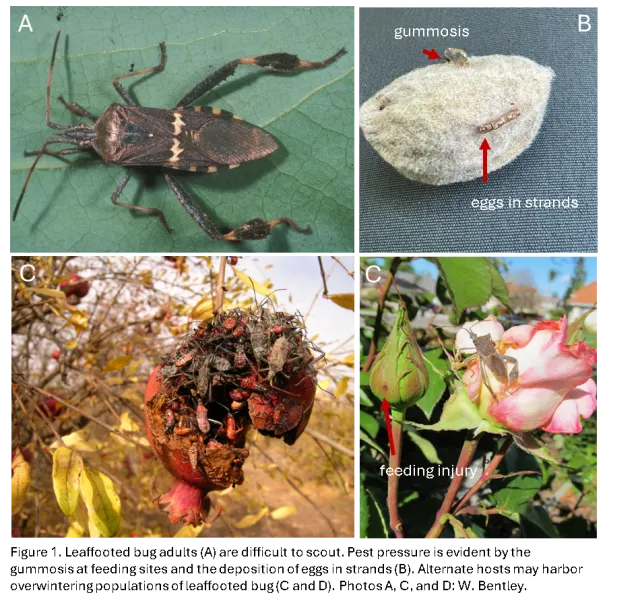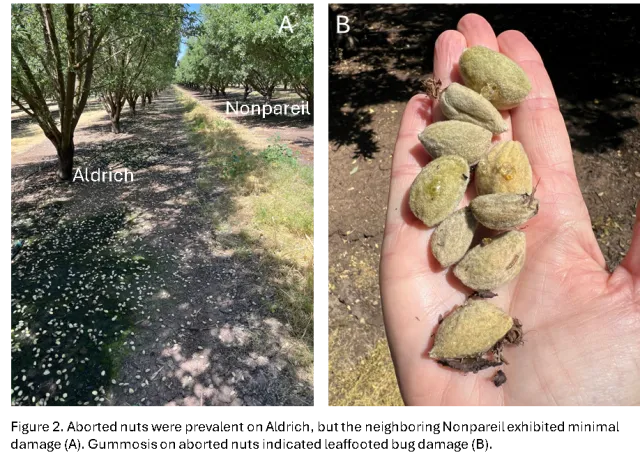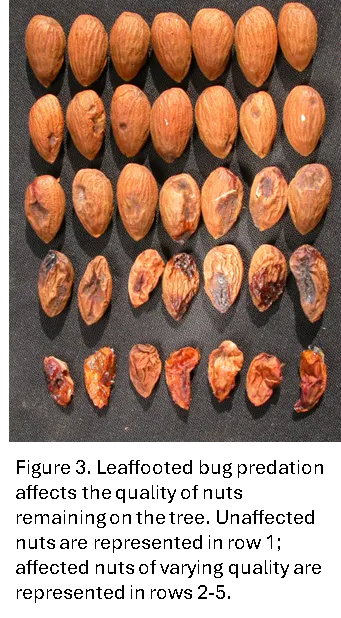Variety and neighboring crops are predictors of leaffooted bug risk in almond
Variety and neighboring crops are predictors of leaffooted bug risk in almond
Elizabeth Fichtner, UCCE Farm Advisor, Tulare County and David Haviland, UCCE Entomology Advisor, Kern County
Leaffooted bug is a sporadic pest in almond, but damage can be significant in years when pest pressure is high. The pest may evade early detection by growers and PCAs because it overwinters as adults in vegetation outside of the orchard and tends to colonize the upper tree canopy, rendering it generally out of sight. As a result, pest pressure is often realized after damage has occurred. The damage may vary considerably between almond varieties, adding yet another challenge for diagnosis.
In Tulare County, heavy leaffooted bug damage was observed in May 2025 in almond orchards surrounded by citrus. Adult leaffooted bugs (Figure 1A) overwintered in the citrus and then entered the neighboring almond orchards in March and April. By early May, symptoms of infestation included extensive nut drop (Figure 2A) and gummosis on the nuts (Figure 2B). Although the adults were not observed in the orchard, the pest was identified based on the observation of the characteristic egg strands of leaffooted bug (Figure 1B). In orchards with Nonpariel and Aldrich, both varieties were affected; however, the nut drop was more extensive in Aldrich than Nonpareil (Figure 2A).
The full impact of the pest may not be realized until harvest because the quality of affected nuts remaining on the tree may also be compromised, thus reducing crop value. Nuts that are stung in late April to early July can be severely shriveled, have sunken lesions, or a brown spot depending on how developed the kernel was prior to feeding (Fig. 3, row 2-5). These nuts stay in the tree, are harvested, and can significantly increase the percentage of nuts classified as inedible during nut quality assessments. When examining a library sample of damaged kernels at harvest, nuts damaged by leaffooted bug fall into the same category as stink bug damage, as kernels damaged by these two pests are indistinguishable.
In 2007, UCCE Kern County Farm Advisors David Haviland and Mario Viveros had the opportunity to evaluate the relative susceptibility of 15 almond varieties to leaffooted bug damage. That year, leaffooted bug invaded a Kern County variety trial research block that included 15 varieties planted in replicated, randomized blocks. This unique situation allowed for unbiased evaluation of the performance of varieties under equivalent pest pressure. Results indicated that the average number of aborted nuts per tree ranged from 0 to 33% of the total crop. Additionally, at harvest, the estimated rejects from leaffooted bug damage ranged from 0 to 30% of the harvested yield. Researchers also noted that crop loss varied by variety, with Fritz exhibiting the highest crop loss at 63%, followed by Sonora, Aldrich, Livingston, Monterey and Carmel. The other varieties in the block had 3% or less total damage from the pest.
The underlying basis for the differential susceptibility of almond varieties to leaffooted bug is unknown. Damage does not appear to be related to harvest date or shell hardness at harvest. Other factors such as plant volatiles, hull thickness, or shell hardness in April and May when the bugs are present may play a role in varietal susceptibility. Haviland and Viveros also noted that varietal susceptibility is somewhat relative, explaining that Wood Colony exhibited low susceptibility to leaffooted bug in the research plot, but significant damage was reported on Wood Colony in commercial orchards when combined with less susceptible varieties (ie. Nonpariel and Carmel). These observations indicate that leaffooted bug prefers certain varieties, but in the absence of a preferred variety, the pest will remain in the orchard and feed on the most preferable variety of the less-preferred varieties present in the orchard.
The 2025 observations in Tulare County, taken in consideration with the 2007 data from the UCCE variety trial suggest that the best way to monitor leaffooted bug is to focus attention on the most susceptible variety in the field. Gummosis and nut drop in the most susceptible variety will serve as an indicator of pest pressure in a given orchard. Growers with Fritz, Sonora, Aldrich, and Livingston should be extra vigilant in monitoring pest pressure. Haviland and Viveros note that orchards composed of relatively unsusceptible varieties will have characteristically lower risk of leaffooted bug damage. Additionally, growers and PCAs should consider pest pressure from surrounding orchards and landscape plants that may serve as overwintering sites for the adults, thus contributing to the cryptic nature of the pest.
Management programs for leaffooted bug consist of monitoring for the pest and spraying primarily with pyrethroids, when needed. Pest management guidelines for leaffooted bug and other pests can be found at www.ipm.ucanr.edu and reports of Almond Board of California-sponsored research can be found at https://www.almonds.com/research-database.
Figures
Figure 1. Leaffooted bug adults (A) are difficult to scout. Pest pressure is evident by the gummosis at feeding sites and the deposition of eggs in strands (B). Alternate hosts may harbor overwintering populations of leaffooted bug (C and D). Photos A, C, and D: W. Bentley.
Figure 2. Aborted nuts were prevalent on Aldrich, but the neighboring Nonpareil exhibited minimal damage (A). Gummosis and egg strands on aborted nuts indicated leaffooted bug damage (B).
Figure 3. Leaffooted bug predation affects the quality of nuts remaining on the tree. Unaffected nuts are represented in row 1; affected nuts of varying quality are represented in rows 2-5.



